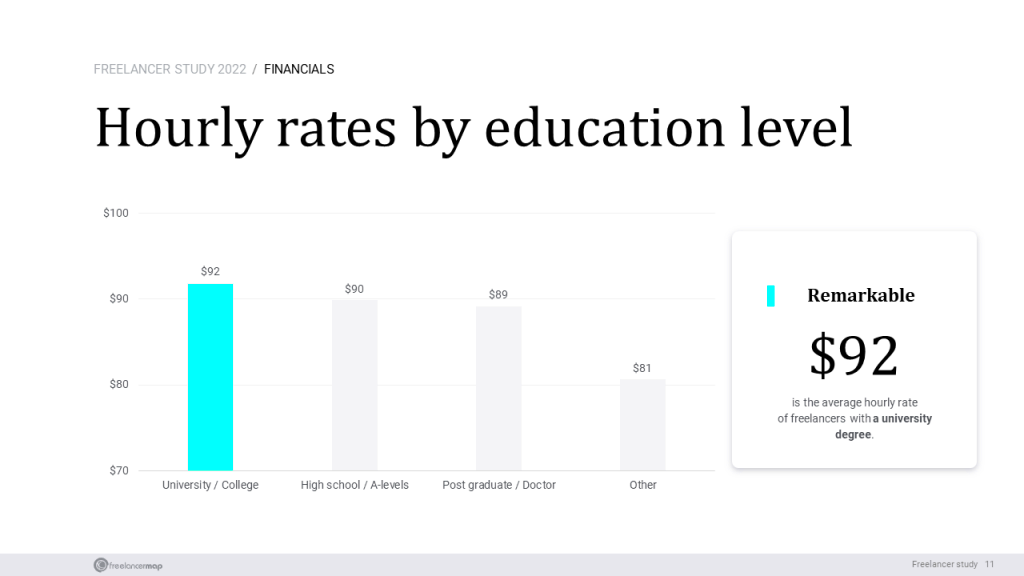Pricing freelance work is quite complicated, particularly for beginners. The way you set your prices must mirror your expertise, levels of value and market considerations. Charging less in order to pull clients may lead someone into extra work that earns less money. Alternatively, too high a charge exerts fear among prospective customers. But to build a lasting career as a freelancer, one must find that sweet spot that enables him or her to progress in life.
Typically, there are two primary pricing models that freelancers apply: hourly and project-based. Both systems have benefits and downsides that will depend on the category of labor you are doing and what the client requires. Understanding this would help you pick out the most suitable price structure for your services.
Factors That Influence Freelance Rates

Your freelance services can be charged differently depending on several factors. Being aware of these variables, can help in rationalizing your prices and making sure that you are paid well for the work done.
- Experience: The more experience you have, the more you can charge. Clients expect to pay more for freelancers who have a proven track record.
- Industry: Different industries have different rate expectations. For example, freelance designers may charge differently from freelance writers.
- Location: Freelancers in high-cost living areas often charge higher rates than those in regions with lower living expenses.
- Project Complexity: More complex projects require specialized skills, which can increase your rates.
- Turnaround Time: If a client needs work completed quickly, they may be willing to pay a premium for faster delivery.
Using these elements will assist you in determining a competitive price that corresponds with skills and customer needs.
Also Read This: Can I Change My Review on Fiverr After Posting?
How to Determine Your Hourly Rate

Hourly is one of the most used freelance payment methods. But how can you come up with an hourly rate? It is an understanding of private expenditures, market fees and the value of time.
This is a formula that is very easy to follow for determining your base hourly rate.
Hourly Rate = (Desired Annual Income + Business Expenses) ÷ Billable Hours
Let us analyze the pieces:
- Desired Annual Income: Think about how much you want to make in a year. This should cover both your personal living expenses and savings.
- Business Expenses: Include costs such as software, equipment, marketing, and taxes.
- Billable Hours: These are the actual hours you can work on client projects. Be realistic – no one works 40 billable hours a week every week!
The adjustment of your base rate can be done according to the skills, demand in the job market and level of experience that you have. It is also wise to study on the amount charged by other freelancers in your field so as not to be left behind by others who offer similar services.
Also Read This: How to Gig on Fiverr: First Page Tips
Project-Based Pricing vs. Hourly Pricing

In determining the most appropriate method for charging clients, freelancers often find themselves torn between project-based pricing or hourly pricing. Each of these approaches has its advantages; however, it is essential to note that one will work better than the other based on factors such as the nature of the work involved, the client’s financial capabilities as well as one’s own time management preferences.
Hourly Pricing is straightforward. You charge for the exact amount of time you spend on a task, making it easy to track and invoice clients. However, the downside is that it can penalize fast workers. If you're efficient, you may end up making less compared to someone who takes longer to complete the same task.
Project-Based Pricing allows you to charge a flat fee for the entire project, regardless of how long it takes. This method works well if you're highly skilled and can complete tasks quickly, as it rewards efficiency. It also gives clients the security of knowing exactly how much they’ll pay upfront. However, if the project scope changes or takes longer than expected, you could end up doing extra work without additional compensation.
| Pricing Model | Pros | Cons |
|---|---|---|
| Hourly Pricing |
|
|
| Project-Based Pricing |
|
|
In conclusion, the decision on which of the two approaches to take will be highly dependent on your taste and the nature of projects that you handle often. A few freelance workers actually employ a combination of either depending on the needs of their clients.
Also Read This: Top 10 Dietitians on Fiverr in 2024
Industry Standards for General Freelance Work
While determining your rates, it is crucial to know how much others in your profession charge. Freelance charge rates vary widely depending on the kind of work undertaken; nonetheless, having an overall notion can help ensure that you do not overestimate or underestimate yourself.
The following is a summarized list of some popular freelance sectors along with their usual pay scales:
| Industry | Hourly Rate Range | Project-Based Pricing Range |
|---|---|---|
| Writing/Content Creation | $25 - $100 per hour | $200 - $2,000 per project |
| Graphic Design | $30 - $150 per hour | $500 - $5,000 per project |
| Web Development | $40 - $200 per hour | $1,000 - $10,000 per project |
| Marketing/SEO | $50 - $150 per hour | $500 - $5,000 per project |
However, your experiences, expertise and even complexity of the project will also determine how far you fall into these categories. In addition, certain areas may set higher/lower examples on standards which means that it is better to find some information about local prices.
Also Read This: When Will Fiverr Let You Change Your Username?
How to Adjust Your Rates as You Gain Experience
In fact, as a freelancer you eventually reach a point where you have to rework your fees. More experience means more value to customers so that should be captured by any change in price. Yet, how can one tell if it is time for them to hike their charges?
1. Regularly Assess Your Skills: If you’ve developed new skills or completed larger, more complex projects, it might be time to increase your rates. Clients are usually willing to pay more for specialized skills that deliver better results.
2. Track Market Demand: Freelance markets fluctuate, and what was a reasonable rate last year may be too low today. Research your industry regularly to see if rates have gone up, and adjust yours accordingly.
3. Provide Notice to Existing Clients: If you’re planning to raise your rates, give your existing clients advance notice. Most clients understand that rates increase over time, and giving them a heads-up shows professionalism. You can offer to keep their current rate for a set period to ease the transition.
4. Test with New Clients: A great way to test higher rates is by quoting them to new clients. Since they don’t have a previous benchmark for your pricing, you can experiment to see if your new rate is accepted without risking your current client relationships.
After compiling more testimonials, advancing your skills, and creating a portfolio, the time comes when it is easier and justifiable to increase your rates.
Also Read This: How to Get Clients on Fiverr as a Beginner
Communicating Your Rates to Clients
One of the most challenging parts of freelancing is the task of communicating rates to clients. Balancing out being self-assured with your price and adjusting it so that it does not become too rigid can help you get more clients without devaluing yourself in their eyes. The way that you present your prices can greatly influence the perception people have about how much value you provide as a professional service provider, hence it’s vital to do this accurately.
1. Be Clear and Upfront: From the start, clearly outline your pricing structure, whether it's hourly or project-based. This avoids confusion later on. You can include your rates in your initial proposal or during the discovery call, but make sure it’s discussed early in the process.
2. Explain the Value: Don’t just state your price—explain what the client is getting for that amount. Break down the services you’ll provide, the time it will take, and the results they can expect. This helps clients understand why your rates are set at that level.
3. Be Open to Negotiation (Within Reason): Some clients might try to negotiate a lower rate. While it’s okay to be flexible, ensure that any changes still make the project worth your time. If you reduce your rate, consider adjusting the scope of work to match.
4. Offer Pricing Tiers: You can give clients multiple options by offering different packages or pricing tiers. This allows them to choose the service level that best fits their budget while ensuring you’re not undervaluing your work.
When presenting your rates, do it in a professional manner and with clarity; hence it becomes easier for clients to perceive you as an expert and well-organized freelancer thus agreeing to your conditions.
Also Read This: Does Fiverr Pay Well? A Comprehensive Guide to Earnings on the Platform
Frequently Asked Questions
Freelancers are often left with queries about freelancing prices. Here are some common questions that will be answered:
- How do I know if I'm charging too much or too little?
It’s essential to research the market and compare your rates to others in your industry. If clients frequently push back on your rates, you may be charging too high. If you’re overwhelmed with work, you may be charging too low. - Should I charge different clients different rates?
Yes, it’s common to adjust rates based on the client’s industry, the complexity of the project, or their budget. Just make sure you’re consistent with how you adjust and always deliver value for the rate you charge. - How do I handle clients who want to pay less?
Politely explain your rate and the value you provide. If needed, offer a reduced service package that fits their budget rather than lowering your rate for the full scope of work. - When should I raise my rates?
You should consider raising your rates when you gain more experience, take on larger or more complex projects, or if market demand increases. Always communicate any rate increases in advance.
Conclusion on Setting Freelance Rates
Establishing freelance costs requires artistry and scientific knowledge. You have to combine your monetary objectives with market’s ability to bear those rates while making sure you showcase the worth you add to your clients’ lives. Be it hourly or project based payment system, the most critical aspect is being assertive; take charge of your own message and vibes.
Having a flexible working schedule is one of the reasons why freelancing has become popular. However, it is crucial that you set rates that will not only help you to survive but also thrive when working as a freelancer. In order for someone who wants to engage in freelance work to have a successful business, they must regularly evaluate their prices, keep up with industry trends and make adjustments as they gain experience in the field. Although building an effective freelance career requires one to understand their value and communicate this well to clients at all times, it also means developing strong client relationships that last long.




